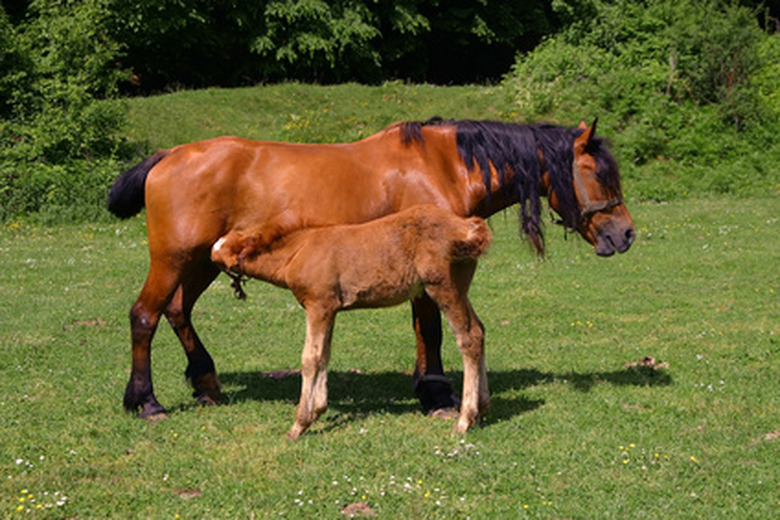The Difference Between Orchard Grass, Tall Fescue And Bluegrass
Orchardgrass is largely grown for pastures and to produce hay and fodder for cattle. Tall fescue and Kentucky bluegrass are grown both for their grazing qualities and for their usefulness as turf. When most people say "bluegrass," they usually mean Kentucky bluegrass that is good for both pastures and popular for lawns, playing fields and golf courses.There are other varieties of bluegrass that are considered invasive weeds on turf.
Orcdhardgrass
Orchardgrass (Dactylis glomerata L.) is a tall, cool-season perennial grass that is used for pasture, fodder and silage. Orchard grass begins growing in bunches early in the spring, developing and flowering quickly. Unlike many pasture grasses including Kentucky bluegrass, orchardgrass does not spread by above-ground stolons or rhizomes beneath the soil. It grows well in full sunlight and is more tolerant of heat, drought and shade than is Kentucky bluegrass.
- Orchardgrass is largely grown for pastures and to produce hay and fodder for cattle.
- It grows well in full sunlight and is more tolerant of heat, drought and shade than is Kentucky bluegrass.
Tall Fescue
Tall fescue (Festuca arundinacea) is a cool season perennial grass with deep roots that grows in bunches. It thrives in wet meadows and in low, damp pastures. Tall fescue is grown mostly for pastures; it has limited usefulness as turf.
Tall fescue does well in clay that is well drained; improved varieties have been developed that remain green around the year if they are irrigated. Tall fescue does not do well if it is mowed below 1-1/2 inches high, and it does not tolerate traffic well, making it less useful for athletic fields and golf courses.
Tall fescue lawns are overseeded in the fall to prevent them from developing thin, unsightly clumps in hot, dry summer weather.
Kentucky Bluegrass
Kentucky bluegrass (Poa pratensis), native to Europe and parts of Asia and the mountains of Northwest Africa, has spread over most cool, humid areas of the U.S., especially the mid-South. It is grown for pastures and is popular for lawns, golf courses and playing fields.
- Tall fescue (Festuca arundinacea) is a cool season perennial grass with deep roots that grows in bunches.
- Tall fescue lawns are overseeded in the fall to prevent them from developing thin, unsightly clumps in hot, dry summer weather.
Roots of Kentucky bluegrass develop from the nodes of its underground rhizomes and from shoots that grow from the crown of the grass, that point where the stalk meets the ground. These tillers or shoots grow together to form a dense sod. Kentucky bluegrass grows rapidly in the fall and spring and slows in the summer.
Kentucky bluegrass should first be mowed when it is 2 inches high. After that no more than 1/3 of the height of the grass should be cut at one time. Mowing it once a week will usually keep it at the recommended 2 inches high. Up to 2 inches of water are required to keep bluegrass growing and green during hot summer months.
- Roots of Kentucky bluegrass develop from the nodes of its underground rhizomes and from shoots that grow from the crown of the grass, that point where the stalk meets the ground.
- Kentucky bluegrass should first be mowed when it is 2 inches high.
Grazing Comparison
After a three year study, researchers at Purdue University concluded that both calves and cows gained one-half pound more per day grazing on orchardgrass than grazing on tall fescue. After a 10-year study, researchers in Virginia found that while animals gained more weight grazing on orchardgrass, they grained more per acre grazing on tall fescue. The researchers concluded that grazing animals preferred orchardgrass over tall fescue or bluegrass.
Other Bluegrsses
Rough bluegrass (Poa trivialis), similar to Kentucky bluegrass, can be grown as a turf grass. It grows well in shaded moist areas, but does not tolerate drought or heat.
Annual bluegrass (Poa annua) is a common weed on lawns, turf and golf courses, having spread from Europe around the world. It also grows in vegetable and other agricultural crops. The distinctive leaves of annual bluegrass have tips that curve upward, looking like the bow of a boat. Bulbose bluegrass Poa (bulbosus) is another bluegrass that grows as a weed in lawns, golf courses and turf.
- After a three year study, researchers at Purdue University concluded that both calves and cows gained one-half pound more per day grazing on orchardgrass than grazing on tall fescue.
- Bulbose bluegrass Poa (bulbosus) is another bluegrass that grows as a weed in lawns, golf courses and turf.
